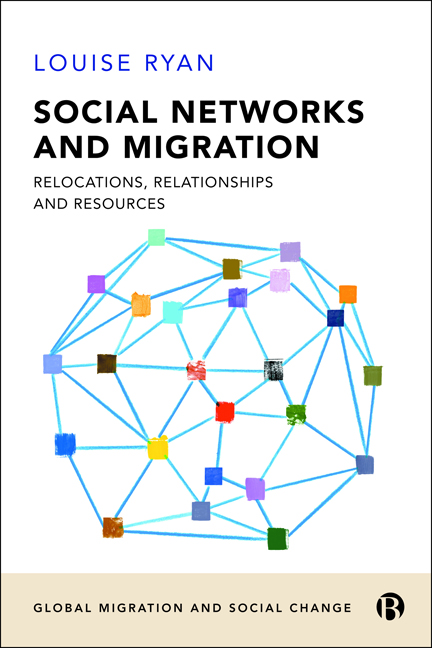Book contents
- Frontmatter
- Contents
- List of Figures
- About the Author
- Acknowledgements
- 1 Introduction: Embarking on a Book about Networks
- 2 Conceptualising Migrant Networks: Advancing the Field of Qualitative Social Network Analysis
- 3 Researching Migration and Networks: Empirical and Methodological Innovations
- 4 Social Networks and Stories of Arrival
- 5 Employment, Deskilling and Reskilling: Revisiting Strong and Weak Ties
- 6 Evolving Networks in Place over Time: A Life Course Lens
- 7 Transnational Ties: Narrating Relationality, Resources and Dynamics over Time
- 8 Conclusion: Thoughts and Future Directions
- Appendix
- Notes
- References
- Index
3 - Researching Migration and Networks: Empirical and Methodological Innovations
Published online by Cambridge University Press: 18 January 2024
- Frontmatter
- Contents
- List of Figures
- About the Author
- Acknowledgements
- 1 Introduction: Embarking on a Book about Networks
- 2 Conceptualising Migrant Networks: Advancing the Field of Qualitative Social Network Analysis
- 3 Researching Migration and Networks: Empirical and Methodological Innovations
- 4 Social Networks and Stories of Arrival
- 5 Employment, Deskilling and Reskilling: Revisiting Strong and Weak Ties
- 6 Evolving Networks in Place over Time: A Life Course Lens
- 7 Transnational Ties: Narrating Relationality, Resources and Dynamics over Time
- 8 Conclusion: Thoughts and Future Directions
- Appendix
- Notes
- References
- Index
Summary
Having discussed the conceptualisation of networks, and explored my epistemological contribution, in the previous chapter, now, this chapter turns to methodology and the techniques that underpin my empirical research. The overall goal of this book is to present my approach to doing qualitative SNA in migration research, through the technique of telling relational stories and drawing pictures of interpersonal connections. This chapter summarises how that approach evolved slowly over the last 20 years of research with migrants.
As discussed in the introductory chapter, my work focuses primarily on London, a city shaped by centuries of migration (Back & Sinha, 2018; Panayi, 2020), to where I moved in the 1990s. Working with migrants who arrived in London at different historical periods draws attention not only to place but also to change over time (Massey, 2007). As argued elsewhere, ‘Migration not only involves spatial but also temporal movement. Migrants are not only moving between countries, they are also negotiating these environments over time’ (Ryan, Lopez Rodriguez and Trevena, 2016). However, as noted by other scholars, it is notoriously difficult to research temporal dynamism (Adam, 2000; McKie et al, 2002; Collins and Shubin, 2015; King and Della Puppa, 2021; Lubbers et al, 2021). Hence, the first aim of this chapter is to discuss my attempts to research change over time. Influenced by Elder's work, I approach time in two ways: first, by drawing on a large corpus of qualitative data collected with migrants who arrived at different historical times, and second, by using longitudinal approaches to reinterview some migrants on several occasions to understand changes in biographical time.
In bringing together migrant stories from across a wide range of research projects, over many years, I faced the challenge of how to present these rich and varied stories in a meaningful way that conveys the diversity of experiences, while being engaging and digestible for readers. Thus, the second aim of this chapter is to explore the use of case studies or thick descriptions (see Thomson, 2007; Phoenix and Brannen, 2014; Stanley, 2015), in making sense of a large and diverse data sets.
Although interviewing individual migrants, it is apparent that their stories present complex relationalities. As Elder also notes, individuals do not experience sociohistorical contexts as isolated actors. The notion of ‘linked lives’ (Elder et al, 2003) highlights the salience of interpersonal relationships in individual biographies.
- Type
- Chapter
- Information
- Social Networks and MigrationRelocations, Relationships and Resources, pp. 37 - 58Publisher: Bristol University PressPrint publication year: 2023



